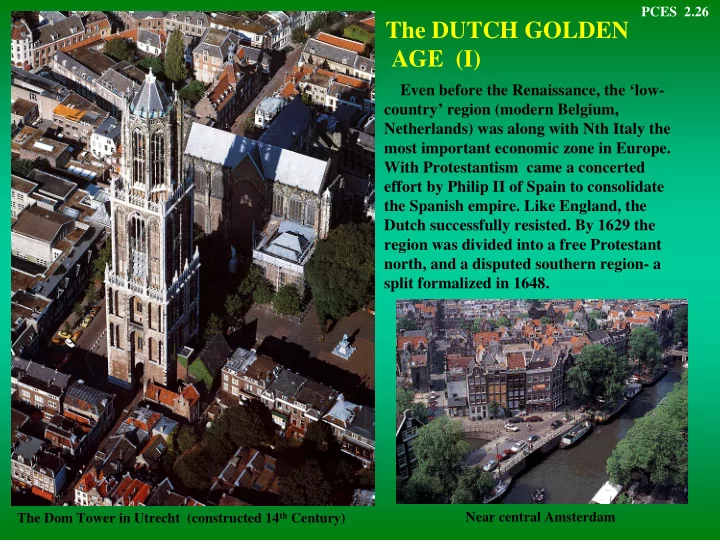

PCES 2.26 The DUTCH GOLDEN AGE (I) Even before the Renaissance, the ‘low- country’ region (modern Belgium, Netherlands) was along with Nth Italy the most important economic zone in Europe. With Protestantism came a concerted effort by Philip II of Spain to consolidate the Spanish empire. Like England, the Dutch successfully resisted. By 1629 the region was divided into a free Protestant north, and a disputed southern region- a split formalized in 1648. The Dom Tower in Utrecht (constructed 14 th Century) Near central Amsterdam
PCES 2.27 The DUTCH GOLDEN AGE (II) From the 1580’s to 1672 a remarkable cultural surge took place, with its zenith in ~ 1650-70. Refugees from war & religious persecution flocked to Amsterdam, now the world’s largest port. Rembrandt, 1640; self-P ‘The Stalmeesters’ (Rembrandt, 1662) ‘Anatomy lesson of Dr N. Tulp’ (Rembrandt, 1632) Danae (Rembrandt, 1636-43)
PCES 2.28 DUTCH GOLDEN AGE (III) The Golden age brought an outpouring of innovation in Art & architecture, & the founding of universities like Leiden (1575) Groningen (1614), & Utrecht (1634). These were the 1 st international universities- over1/2 the students were foreign. Jewish refugees helped found the Amsterdam bourse. Jan Six (Rembrandt, 1654) The separation into strong provinces hindered the power of the church to control intellectual life in the Dutch republic. By 1645, Leiden university was the largest in the Protestant world. Alliances with England maintained the exchanges which had begun ‘The Night Watch’ (Rembrandt, 1642) even before Erasmus.
PCES 2.29 DUTCH GOLDEN AGE (IV) As today, the Dutch depended heavily on trade. With England, they became a great sea power (later tamed by the English). The great Dutch land reclamation project accelerated. After 1630, religious toleration was widespread, but public morals were rigidly controlled. Girl with a Pearl Earring (Vermeer, 1665) The mechanistic & mathematical ideas of Descartes quickly took hold in Holland- his colleague F. van Schootens trained Huyghens. The reactionary movement led by Voetius against Cartesian ideas was unsuccessful- although it inconvenienced Descartes. ‘View of Delft’ (Vermeer, 1661)
PCES 2.30 The ENGLISH CONTRIBUTION The English Renaissance began with the reign of Elisabeth I. Her father Henry VIII had detached England from the Catholic church, and in 1588 the attempt by Philip II of Spain to subdue Elisabeth failed with the sinking of the Armada (as did the Spanish attempt to quell the Dutch). In the 70 yrs after Elisabeth, English society changed completely- in the struggle between the Parliamentarians, inspired by the Dutch republic, & the Royalists, inspired by French absolutism and Louis XIV, Parliament was the clear winner. Because of the changes already made by Elisabeth, religious dispute Elisabeth I (r. 1558-1603) was less crucial to the resolution of the English civil war. At the end of this process England was controlled by Parliament, with considerable freedom and a strong scientific community, with close links to the Dutch republic (cf. the reign of William & Mary), with control of the seas, and a rapidly expanding overseas empire. See W. Shakespeare notes for more details. (1564-1616) A Midsummer Night’s Dream
PCES 2.31 The ENGLISH CONTRIBUTION (II) The 1 st half of the 17 th century in the British Isles was very turbulent- but in the calm of the reign of Charles II a group of men interested in science & united by their belief in ‘empirical philosophy’, formed a group which in 1662 became the Royal Society, blessed by Royal charter. This brought together some remarkable people, including J Locke, C Wren, T Dryden, S Pepys, E Halley, R Boyle, R Hooke, & of course I Newton- as well as Leibniz & Huyghens from Europe. In 1665 the secretary, H Oldenberg, started the ‘ Philosophical Transactions of the Royal Society’ , which still continues- early publications included not only English work but the discoveries of Leeuwenhoek & Malpighi; & Oldenberg’s correspondence with Spinoza, Leibniz, & Huyghens is part of the history of the time. In 1666 the plague sent many city dwellers to the countryside- including a 24 yr old Isaac Newton. GREAT FIRE of LONDON (1667) (preceded by the Plague, 1666-7)
Recommend
More recommend